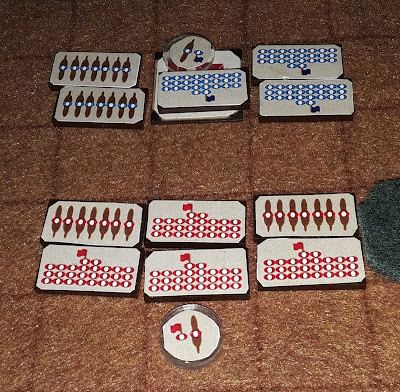Piqued by the quick play opportunities of the 3 x 3 Portable Wargame, I decided to experiment.
3 x 3 Test
First I decided to try a 3 x 3 Portable Wargame. I grabbed 6 units from my tin of generic counters, placed them on a board, and went at it. I never finished.
I found the game lackluster. Because of the constraints of the grid, there was no maneuver. Just march straight forward into the maw of death. Furthermore, I could not score a hit (I'm a bad roller). Combat dragged and, as I suspected, it was just an exercise in dice-rolling.
Fast Play MicroBattle
The problem, I theorized, was not the size of the grid. It was the combat mechanisms. Specifically, the combat mechanisms, whether for PW or my own MicroBattle, too often led to indecisive results. I decided to try out some new mechanisms where combat would be more decisive.
FPMB in a Nutshell
In brief, here are the rules I used.
- Armies comprising 6 units are divided into divisions of 2 units each. Divisions could be all infantry, all cavalry, or mixed.
- Roll a D3 to determine the number of divisions to activate per turn.
- Foot or mixed divisions move 1 space per turn. All cavalry divisions move 2.
- Combat occurs between adjacent units.
- To adjudicate combat, each side rolls a D6 and adds or subtract bonuses due to advantages or disadvantages.
- As usual for MicroBattle, I just tend to eyeball this and give the side with an advantage a +1 modifier.
- The loser takes a Disorder marker and makes additional Resolution Tests
- Morale Test - failure leads to a second Disorder (which eliminates a unit)
- Retreat Test - failure causes the entire division to retreat one square
- Roll for army morale once an army loses half its units
FPMB Test Game
And here are shots of a test game.
Here is my initial set-up using my full-size grid. However, I quickly realized that with a movement rate of 1 space per turn it will take a while before the troops even get into combat.
Lesson learned. Either use a narrower board or create a route march rule to allow forces to advance quicker.
So far, I've essentially been playing a 3 x 3 game. However, the next turn shows the benefit of a bigger grid.
Red is victorious.
Evaluation
So far, I am pleased with the fast play version of MicroBattle.
Observations:
- The above game took approximately 15 minutes.
- Combat seemed to work fine.
- By using an opposed dice roll, attacks usually have some effect. There is only a 1 in 6 chance of a tie, in which case the fight in inconclusive. Otherwise, one division will take a casualty. Furthermore, the division may lose an entire unit and may have to retreat!
- I decided to allow divisions to split - as I did with the cavalry flank march.
- The activation rule makes splitting a division a thought-provoking exercise. You extend your frontage and increase the chance to flank, but it makes it harder to control your army. You are more likely to leave troops sitting around.
- I used a 7 x 8 grid that I created for regular MicroBattle games. This is too big for FPMB. I may create a 5 x 5 grid specifically for FPMB.
- With a smaller grid, I should have room to expand the size of each square. I may use 30mm squares so the 25mm counters will fit a touch better.
- With larger squares, I may have room to add some 3D buildings.
Anyway, stay tuned for more fast play MicroBattle experiments.







Sorry that you didn’t like the 3 x 3 rules, but I’m glad that you found others that were more suitable.
ReplyDeleteAll the best,
Bob
Thanks Bob. I think I missed this comment as well. Sorry about that.
DeleteIt certainly sounds like you’re making good progress. Please let us know how you get on.
ReplyDeleteCheers,
Geoff
Completed another experiment this weekend. I'll probably post about it next weekend. Stay tuned!
Delete